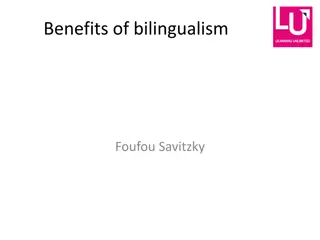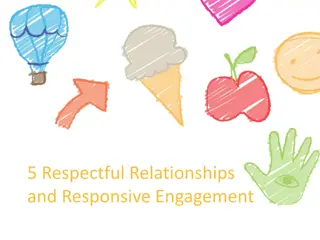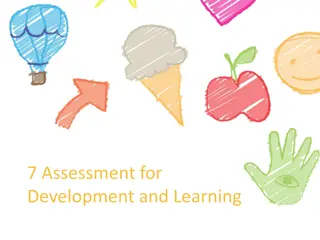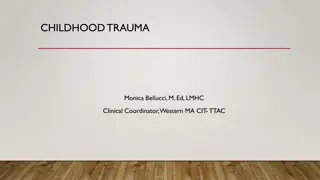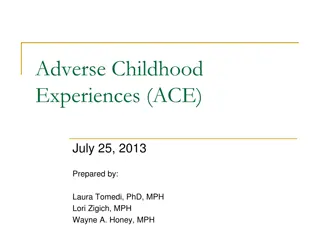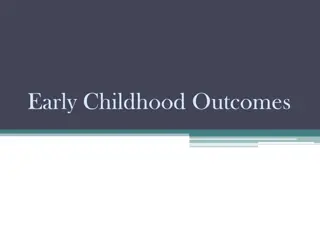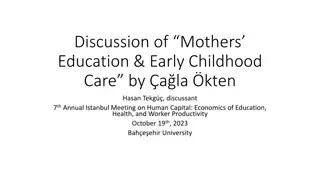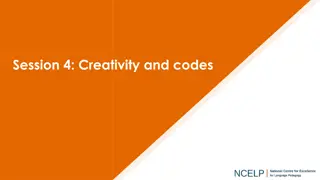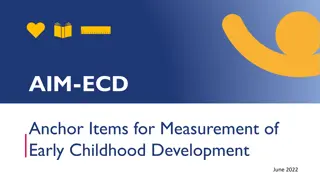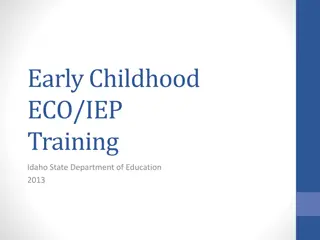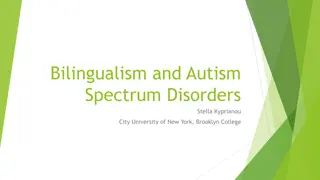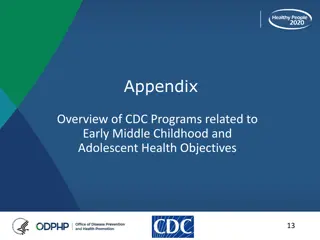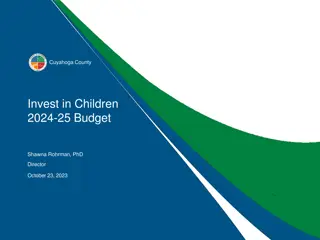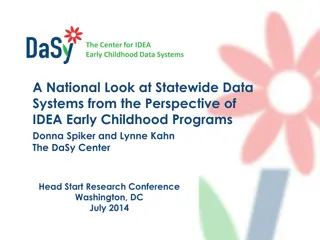Early Childhood Language Learning and Bilingualism
Early childhood is a critical period for language acquisition and the development of bilingualism. Exposure to multiple languages from a young age has significant cognitive benefits. Bilingualism is a common phenomenon worldwide, with many individuals speaking more than one language. The cognitive impacts of learning a second language are profound, benefiting individuals both in childhood and later in life. However, it is important to recognize that exposure to multiple languages does not guarantee equal proficiency in all languages. The cognitive effects of bilingualism are substantial, contributing positively to cognitive skills and language abilities. Research has shown that bilingual children outperform monolingual peers in various tasks, showcasing the cognitive advantages of bilingualism.
Download Presentation

Please find below an Image/Link to download the presentation.
The content on the website is provided AS IS for your information and personal use only. It may not be sold, licensed, or shared on other websites without obtaining consent from the author.If you encounter any issues during the download, it is possible that the publisher has removed the file from their server.
You are allowed to download the files provided on this website for personal or commercial use, subject to the condition that they are used lawfully. All files are the property of their respective owners.
The content on the website is provided AS IS for your information and personal use only. It may not be sold, licensed, or shared on other websites without obtaining consent from the author.
E N D
Presentation Transcript
Konuma izlencesi Erken ocukluk d neminde yeni bir dil renimi Bili sel boyutlar Dilbilimsel boyutlar Dil retiminde neler yap yoruz? T rk e- ngilizce konu an ocuklardan rnekler
kinci/Yabanc dil renimi D nya genelinde yayg n bir olgu D nyan n bir ok yerinde g nl k ya am n bir par as D nya n fusunun yakla k birden fazla dil konu an bireylerden olu uyor (Crystal, 2003)
194 lkede 6000-7000 arasnda farkl dil konu uluyor. Bu say bile ikidillili in ne kadar yayg n oldu unu g stermesi bak m ndan nemli. (Bhatia and Ritchie, 2006).
kinci bir dil reniminin bilisel boyutlar kinci/yabanc dil renimi Yeni bir dilin eklenmesi zihinsel anlamda bireyi s n rlar m ?
Dier bir deyile, ocuklar aras nda sosyo-ekonomik oldu u kadar dile maruz kalma a s ndan bireysel farkl l klar oldu u halde, sa l kl t m ocuklar duyduklar , ileti im ve etkile im kurduklar dil/dilleri renme kapasitesine sahiptir.
Ancak, bu iki farkl dile maruz kalan bireylerin her iki dili de ayn bi imde ve ayn yetkinlikte renece i eklinde anla lmamal .
Bilisel geliime etkileri BU SORUNUN CEVABI: EVET! En b y k etkisi: Hem ocuklukta hem ileri ya larda bili sel s re lere olan etkisidir. Dil st becerilere olumlu etkisi
Bilisel geliime etkileri Ben-Zeev (1977): Referential arbitrariness In a game context she instructed the children as follows: in this game we use the word spaghetti for we , how would you say we are good children .
Bilisel geliime etkileri Ben Zeev (1977): Irrespective of the underlying meaning the children had to say Spaghetti are good children . Bilingual children performed significantly better than monolingual peers in the task. It was easier for bilingual children to ignore the meaning of the sentence and do the required replacement.
Bilisel geliime etkileri Piaget nin nl problemi Piaget s famous the sun-moon problem Monolingual and bilingual children were taught new names for things where the new names were either the real names for objects or nonsense words. Only the bilinguals were successful in using the new or nonsense words in sentences.
Bilisel srelere etkileri Her iki dili d zenli kontrol ve idare etme durumu bili sel anlamda y netsel kontrol sistemini geli tiriyor.
Ynetsel kontrol sistemi neden nemli? En temel bili sel s re leri kontrol ediyor: Haf za/bellek geli imi Bili sel esneklik Sorgulama Problem zme, Planlama ve icra etme gibi.
Sylemeden gemeyeyim: Y netsel kontrol sistemi ya la birlikte nemli l de yava l yor ve d yor. Tehlike anlar : 35-40 l ya larda gerileme ba l yor.
zetle, birden fazla dil bilme/konu man n bili sel yararlar Zihinsel esneklik Kavram geli tirmede st nl k Daha e itli t rde zihinsel yetilerin geli imi
Bu konuda imdilik son sz: N rolojik olarak beynimiz, onu nas l kulland m z ve onunla ne yapt m za ba l olarak de i iyor.
Dilbilimsel adan neler s yleyebiliriz? Bir ba ka dili renmenin dilsel zellikleri nelerdir? Birden fazla dil nas l renilir? ocuklar nas l renir? leri ya larda nas l renilir?
Anadil geliimi Normal geli im g steren her ocuk evresinde konu ulan dili renir/ renme kapasitesine sahiptir.
Ana dil geliiminin tersine, ikinci/yabanc dilde m kemmel dil yeterli ine eri mek o u zaman istisnai bir durum olarak g r l r.
Ana dil geliimi ile ikinci/yabanc dil geli imi aras nda en nemli farklardan biri: kinci dil geli iminde rencinin dilsel ve bili sel olarak daha olgun bir geli im evresinde bulunuyor olmas d r.
Ardk olarak ikinci bir dil renen ki i/ ocuk zaten bir ba ka dil edinim evrelerini ya am t r/ya amaktad r.
Anadilin ikinci dil geli imi zerine etkileri var m d r? Varsa, bu etki nas l g r l r?
Genel kan: Erken ya ta dil renenler daha ba ar l d r. Erken ya ta dil renenlerde anadilin etkileri g r lmez!
Erken yata dil renenler anadilini renir gibi ikinci dili renir. BU DO RU DE L!
Yllar nceki almalarda, anadilin ikinci/yabanc dil zerindeki etkileri Turkish-like sentences (OV, SOV) (1) a. Ara t rmac : Look at those boys Erdem. What are they doing? ocuk: # ball playing b. Ara t rmac : Where are we going now? ocuk: Newcastle going. (Haznedar, 1997) (2. ay) (2. ay)
Gekin (2006): Erken ya ta veya ileri ya ta ngilizce renenlerde g r len zellikler: a. Ara t rmac : What happened to this car? ocuk: Car was broken. b. ocuk: But the gingerbreadman can t stay near dog. (p.146) En yayg n yanl t rleri (p.143)
Bir baka yaygn yanl tr: T rk e de dilbilimsel olarak cinsiyet ayr m olmad i in, bazen rencilerimiz y llarca dil renimine ra men HE yerine SHE , SHE yerine HE kullanabiliyor.
Dil renimi karmak ve uzun bir s re tir. Dilde baz zellikler erken baz zellikler ge renilir.
Anadili ngilizce olan tekdilli ocuklar, ngilizce de baz zellikleri di erlerinden nce renir.
ACQ. ORDER MORPHEME EXAMPLE 1 PRESENT PROGRESSIVE -ING 2 PREPOSITION ON 3 PREPOSITION IN 4 PLURAL -S (as in two books) 5 IRREGULAR PAST FORMS (as in shewent) 6 POSSESSIVE S ( as in daddy s hat) 7 UNCONTRACTIBLE COPULA IS (in she is) 8 ARTICLES THE and A 9 REGULAR PAST -ED (Shewalked) 10 REGULAR THIRD PERSON SINGULAR -S ( as in she runs) 11 IRREGULAR THIRD PERSON SINGULAR SINGULAR FORMS ( she has) 12 UNCONTRACTIBLE AUXILIARY BE (Shewascoming) 13 CONTRACTIBLE COPULA (She s tired) 14 CONTRACTIBLE AUXILIARY BE (as in he s coming)
Additionally, it must be kept in mind that errors are both product and process of learning. Learners may commit errors systematically nonsystematically overgeneralization, new category or rule, ignorance of rule restriction, incomplete application transfer, developmental error types and simlification by omission. and of because of rules,
Benzer ekilde belli bir renme s ras ikinci bir dil renirken de var m ? BU SORUNUN CEVABI EVET!
Farkl dilden gelen ocuklar ne yap yor? Dulay & Burt (1974): Anadili ngilizce olan ocuklar n ngilizce renimi s ras nda izledi i evrelerin ayn s de il, ama spanyolca ve ince konu an ocuklar da ngilizce yi belli bir s ra izleyerek renmi lerdir. dilden gelen ocuklar ne yap yor?
Trke konuan ve ngilizce renen ocuklar ne yap yor?
The frequency of the words used by children has been analysed by Lexical Tutor http://www.lextutor.ca/freq/ TomCobb, 2015. Compleat v.3
FINDINGS AND DISCUSSION When the fourth graders written descriptions of the house with the householders in both Turkish and English have been analysed in terms of their linguistic competence through corpus analysis, it has been detected that they have used 1848 vocabulary items totally in English, whereas they have used 1577 in Turkish. However, the types of the vocabulary items were 334 in English, while they were 469, which indicates that they know more different vocabulary items in their native language although they use more repeated words in English because of memorization.
The average number of the English sentences is 12.91, whereas it is 13.15. This indicates that they tried to use almost the same number of sentences in descriptions because translation corpora, which represents their translations into one or more languages and comparable corpora. their bilingual of both
In English version the fourth graders generally seem to have used simple sentences made by routine patterns and prefabricated formulas, such as Salih is flying a kite; Ay e is drawing a picture; Mom is cooking; in the bathroom he is swimming. In Turkish version they seem to express the actions not only by simple sentences but also by complex and sentences: compound complex
Erkek banyoda gzlk, tp ve paletle k vette y z yor; K z resim yap yor ve onun yan ndaki erkek u urtma u uruyor; Anne orba yap yor. As is seen above , they are more expressive in Turkish with the use of compound complex sentences and detailed words as sea urchin, oxygen tube, sea palette, tub, and soup.
When the texts are analysed in terms of the corpus analysis, it gives us the frequency of the words used in the developed texts of the fourth graders. According to the word classes, the following charts can be given:
A- ENGLISH TEXTS Table 1 The number of theArticles used by the Fourth graders Articles A An The Number (N) 118 1 118 % 6.39 0.05 6.39
The fourth graders seem to use definitearticleas frequentlyas indefinite articles a . When weanalyze the definiteness in theirdeveloped Turkish texts, they seem better in Turkish, since it is their mother tongue, as in : Mavi odada adam suya dal yor. Adam at da u urtma u uruyo. erke in evin tepesinde u urtma u urdu unu g r yorum. Banyoda bir ocuk var. In both languages to make the agents definite, they prefer Person names:
Common English and Turkish Proper Names MURAT AHMET AY E FATMA ZEYNEP ESRA YUSUF G KHAN HAT CE SAL H KEZBAN
Table 2 Prepositions down Prep. in on to of at out with from for N 81 20 6 6 8 7 3 1 1 6 % 4.38 1.08 0.32 o.32 0.43 0.38 0.16 0.05 0.05 0.32
When the prepositions have been analyzed, it is seen that the preposition in is the most used one. Children s first prepositions carry much the same information as street signs. They express locations and directions. (O Grady2005: 72). Therefore, here the prepositions from and for seem less used. In terms of language acquisition, it verifies the acquisiton order of the prepositions.
Table 3 The verb Copula Copula am is are was N 0 143 7 1 % 0 7.74 0.38 0.05
Since descriptive texts according to the given picture, the children have been able to sentences, which can correspond to those of native language users in language acquisition. they have written a use existential
Table 4 Personal Pronouns Person al Pronou n I You He She It We They N 36 0 25 26 2 0 5 % 1.95 1.35 1.41 0.11 0.27
Children seem to have used personal pronoun I more than the other personal pronouns. As O Grady (2005.76) claims they avoid using pronouns altogether in favor of names. In their descriptive texts of the picture, they have given some names they are familiar to the characters as we discussed before.



